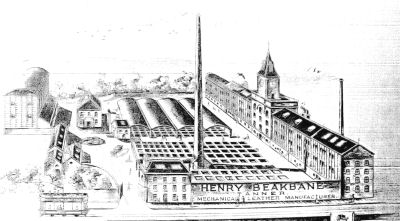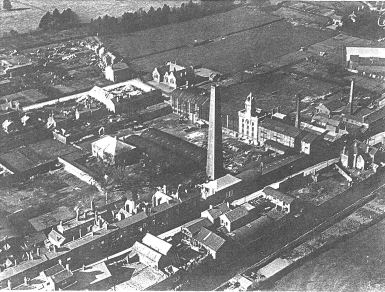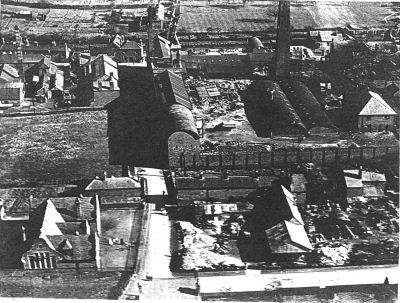
In medieval times every village had its tannery, supplying leather for anything from horse harnesses to belts for water power machines. The Stourport Tannery was built in 1702, probably by the Nash family, no doubt they we delighted when the canal arrived and they were able to expand to such an extent that they became the largest Tannery outside London.
The works stretched across both sides of Lombard Street, backing onto the canal where the company had a wharf, for it received raw materials by barge, from the canalside you would have seen the men patiently pushing the hides down into the pits with their long poles. Worcester Street was built by the Rogers family for Tannery workers. Wagons used to arrive bringing in great loads of bark from Ribbesford woods. Stripping bark was considered to be a woman's job. The bark was piled into huge ricks, like gigantic hayricks. An elderly lady by the name of Betty Birch brewed ale at the back of the Tannery and the tables were loaded with bread and cheese, so that carters and dealers were never sent away empty-handed.
There were several ricks in the Tannery grounds, one in Tan Lane and another in Lion Hill. These were, of course, highly inflammable and one of them was once set on fire by small boys playing with matches. The Tannery chimney was built in 1831 by Thomas Ward and remained a local landmark for years. It was 203 feet tall and 25 workmen could sit round the top, an impressive piece of work. One of the workers once climbed to the top 'and waved a flag to his missus'. Thomas Ward is re¬membered for the carvings he donated to the Methodist Church.
Sometime later, in about 1860, the Tannery was almost completely burned down. No-one knows how the fire started; perhaps small boys were playing with matches again. It began on the Saturday and burned until the following Tuesday week. At that time it was owned by two brothers, John Crane Rogers and Joseph Rogers who had come from Martley. Joseph Rogers was fetched from Areley House by one of his workmen and when he saw the raging flames from the top of the street 'he was speechless'.
A splendid new factory was built including the great chimney stack which had a cracked . The new factory had an ornate Gothic tower complete with clock, a useful addition for the many people who, in those days, could not afford a watch. Not everyone was delighted by the clock. There was only a clock face on the works side so that the time could not be seen by the town folk. Twenty years later it seemed to have ac¬quired a mind of its own, for when the little finger was at nine and the big one at two, the clock would strike ten and the workers would know that it was half-past four.
After the rebuilding of the Tannery Mr Rogers seems to have lost interest. Isaac Wedley says that the Tannery 'suffered from his predilection for horses and hunting', and hints at a lawsuit. The Tannery went into liquidation and was sold for a quarter of its value, then it changed hands again at twice the figure and was bought by a Mr Henry Hall Beakbane in 188O for £5,000. The name Beakbane is Celtic and means a worker in bone and skin so per¬haps his family had been tanners for hundreds of years. He came from Cheshire where his business had flourished, despite the fact that he and his family were Quakers. At first he must have regretted his move to Stourport. Local materials were disappearing, and the cutting back of the Wyre Forest greatly affected the supply of oak bark. With the railways replacing horse-drawn transport the need for harness leather decreased and even the craftsman cobbler was put out of business by factory-made shoes. The tannery ran at a loss for a while until it closed in 190l.
Then in 1908 Mr Beakbane's son, also named Henry, returned from America having learned new methods of tanning. The old Tannery was re¬opened and modernised and the great chimney stack demolished. The yard turned out leather for driving-belts, pimp cups, washers and other engineering requirements. There was a recession during the First World War but when peace returned new lines were started.
The Tannery began to supply fine sheepskin leather to the Worcester glove trade in 1927. They changed over to light leather for shoe uppers, gloves, coats and handbags using both sheep and goat skins from India. The great demand for this high quality material encouraged skilled men to come to live and work in Stourport.
The Beakbane family continued to run the business until the early 1960s when they was another terrible fire. It was never rebuilt and the business was transferred to Kidderminster. For many years the site was used by Thomas Vale and Co Ltd, and is now the site of a Co-Operative Supermarket.


